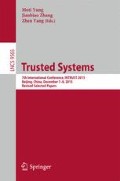Abstract
Partial decryption enables a ciphertext to be decrypted partially according to provided secret keys. In this paper, we propose a public key encryption scheme with the functionality of partial decryption. Our strategy is to use the NTRU cryptosystem. Under a design principle of the mathematical structure “group ring”, we extend the original NTRU into group ring NTRU (GR-NTRU). First, we propose a generic framework of our GR-NTRU. Our GR-NTRU allows partial decryption with a single encryption process using a single public key. Besides, when we execute partial decryption under a secret key of GR-NTRU, we need no information to identify each part in a whole ciphertext. Consequently, management of a public key and a corresponding set of secret keys is rather easier than the naive method. Next, we propose a concrete instantiation of our generic GR-NTRU. A multivariate polynomial ring NTRU scheme is obtained by employing a product of different cyclic groups as the basis of the group ring structure. We will show examples of those new variants of NTRU schemes with concrete parameter values, and explain how we can employ them to use the functionality of partial decryption.
This research is commissioned by “Strategic Information and Communications R&D Promotion Programme (SCOPE), No. 0159-0016” Ministry of Internal Affairs and Communications, Japan.
Access this chapter
Tax calculation will be finalised at checkout
Purchases are for personal use only
References
Ateniese, G., Chou, D.H., de Medeiros, B., Tsudik, G.: Sanitizable signatures. In: di Vimercati, S.C., Syverson, P.F., Gollmann, D. (eds.) ESORICS 2005. LNCS, vol. 3679, pp. 159–177. Springer, Heidelberg (2005)
Bellare, M., Boldyreva, A., Staddon, J.: Randomness re-use in multi-recipient encryption schemeas. In: Desmedt, G. (ed.) PKC 2003. LNCS, vol. 2567, pp. 85–99. Springer, Heidelberg (2003)
Berkovits, S.: How to broadcast a secret. In: Davies, D.W. (ed.) EUROCRYPT 1991. LNCS, vol. 547, pp. 535–541. Springer, Heidelberg (1991)
Boneh, D., Gentry, C., Waters, B.: Collusion resistant broadcast encryption with short ciphertexts and private keys. In: Shoup, V. (ed.) CRYPTO 2005. LNCS, vol. 3621, pp. 258–275. Springer, Heidelberg (2005)
Bovdi, A.A.: Group Algebra. Springer Publishing Company, Incorporated (2001)
Boyle, E., Gilboa, N., Ishai, Y.: Function secret sharing. In: Oswald, E., Fischlin, M. (eds.) EUROCRYPT 2015. LNCS, vol. 9057, pp. 337–367. Springer, Heidelberg (2015)
Brzuska, C., Fischlin, M., Lehmann, A., Schröder, D.: Santizable signatures: how to partially delegate control for authenticated data. In: Proceedings of the Special Interest Group on Biometrics and Electronic Signatures BIOSIG 2009, 17-18 September 2009 in Darmstadt, Germany, pp. 117–128 (2009)
Hoffstein, J., Howgrave-Graham, N., Pipher, J., Silverman, J., Whyte, W.: Hybrid lattice reduction and meet in the middle resistant parameter selection for ntruencrypt
Hoffstein, J., Pipher, J., Silverman, J.H.: NTRU: a ring-based public key cryptosystem. In: Buhler, J.P. (ed.) ANTS 1998. LNCS, vol. 1423, pp. 267–288. Springer, Heidelberg (1998)
Izu, T., Ito, K., Tsuda, H., Abiru, K., Ogura, T.: Privacy-protection technologies for secure utilization of sensor data. Fujitsu Sci. Tech. J. 50(1), 30–33 (2014)
Sahai, A., Waters, B.: Fuzzy identity-based encryption. In: Cramer, R. (ed.) EUROCRYPT 2005. LNCS, vol. 3494, pp. 457–473. Springer, Heidelberg (2005)
Santis, A.D., Desmedt, Y., Frankel, Y., Yung, M.: How to share a function securely. In: Proceedings of the Twenty-Sixth Annual ACM Symposium on Theory of Computing, 23–25 May 1994, Montréal, Québec, Canada, pp. 522–533 (1994)
Shamir, A.: How to share a secret. Commun. ACM 22(11), 612–613 (1979)
Yamada, S., Attrapadung, N., Santoso, B., Schuldt, J.C.N., Hanaoka, G., Kunihiro, N.: Verifiable predicate encryption and applications to CCA security and anonymous predicate authentication. In: Proceedings 15th International Conference on Practice and Theory in Public Key Cryptography PKC–2012, Darmstadt, Germany, May 21–23 2012, pp. 243–261 (2012)
Yasuda, T., Dahan, X., Sakurai, K.: Characterizing NTRU-variants using group ring and evaluating their lattice security. To be appear as an IACR e-print paper
Author information
Authors and Affiliations
Corresponding author
Editor information
Editors and Affiliations
Rights and permissions
Copyright information
© 2016 Springer International Publishing Switzerland
About this paper
Cite this paper
Yasuda, T., Anada, H., Sakurai, K. (2016). Application of NTRU Using Group Rings to Partial Decryption Technique. In: Yung, M., Zhang, J., Yang, Z. (eds) Trusted Systems. INTRUST 2015. Lecture Notes in Computer Science(), vol 9565. Springer, Cham. https://doi.org/10.1007/978-3-319-31550-8_13
Download citation
DOI: https://doi.org/10.1007/978-3-319-31550-8_13
Published:
Publisher Name: Springer, Cham
Print ISBN: 978-3-319-31549-2
Online ISBN: 978-3-319-31550-8
eBook Packages: Computer ScienceComputer Science (R0)

